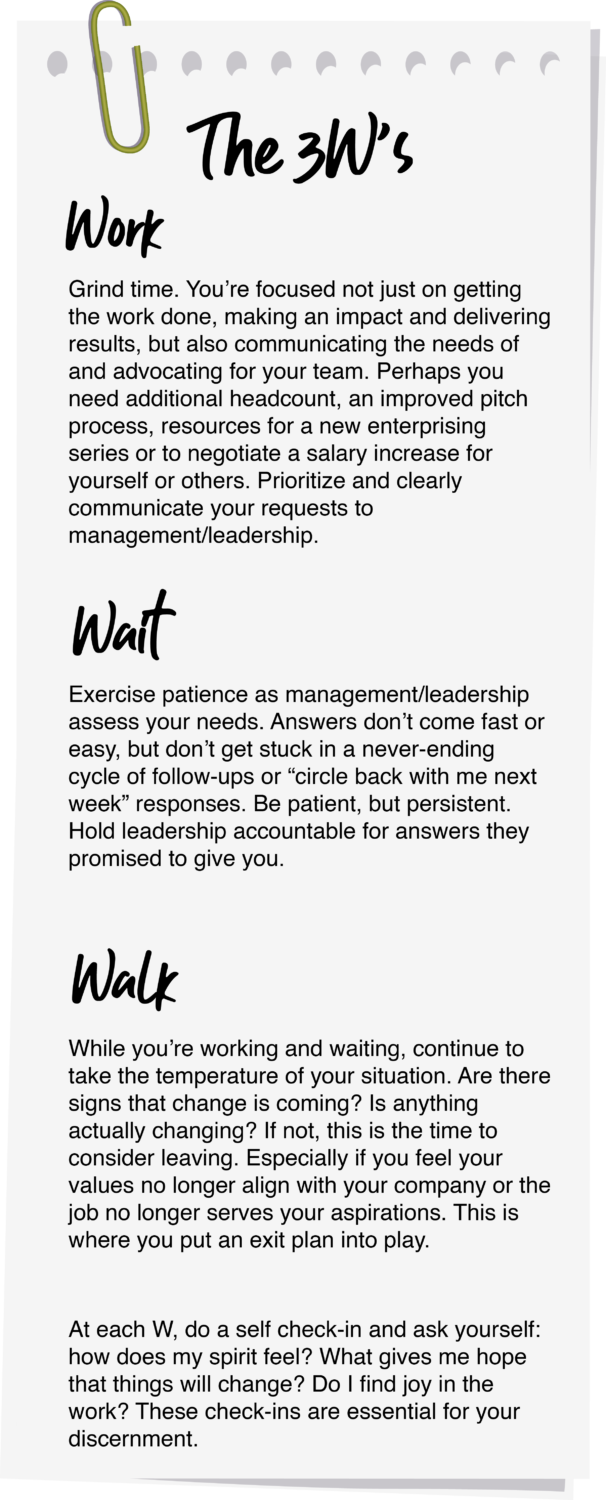Christina M. Tapper is an award-winning digital sports and culture editor. In 2018, Folio named her one of its distinguished Top Women in Media and honored her as a “Change-Maker.” She also graduated from Poynter’s Leadership Academy for Women in Digital Media in November 2018. She is currently enjoying a self-imposed career break.
After two and a half years of working at a top sports media company — and nearly a year after my promotion to a coveted managing editor role — I chose to step away from it all.
The decision, as you can imagine, wasn’t easy. There was so much to love about my job: working with some of the smartest and most creative people in sports media, leading an editorial team of writers and editors responsible for premium innovative storytelling and helping to increase coverage of female athletes. But there was also so much chipping away at me during the last year on the job: a heavy workload pummeling me with long hours, limited autonomy and lack of support.
Above all, I was seeking clarity and resources necessary for my team members to be top performers—and for me to build a supportive work culture that fosters talent, experimentation and ambition. I felt limited, and on some days small. Burnout seemed imminent.
Ultimately, it came down to a choice to prioritize my best interests in a career field that often deprioritizes the needs of women, especially Black women. So I quit. On good terms, but most importantly on my own terms.
Because I took some time, and steps, to make my decision, I was resolute — and ready to rest and recalibrate. Whether you are anticipating layoffs, contemplating your family balance, or want to fund your own career break like me, here are some tips for quitting gracefully.
The Decision: Power Through, Be Patient, Peace Out
While I took a close look at my circumstances at work and monitored how I was feeling throughout the year, I leaned on the 3Ws—work, wait and walk. It’s a workplace evaluation tool I crafted for myself to assess and manage the multiple, often intense, shifts at work and the pendulum of emotions that came with them.
By exercising the 3Ws, within a reasonable timeframe, I was able to discern whether I should continue to power through or peace out.

I was already working, a lot, when I went into “wait” mode at the end of May 2018. The plan: give myself six months to wait for the additional support and resources necessary for my leadership and determine what my next steps would be if my requests weren’t granted.
I did a small-scale job search, but deep down I knew if the decision was to leave, it wouldn’t be for another job. It would be for rest.
Emotional and physical exhaustion was mounting. Meanwhile, I confided in my therapist who I saw weekly (Mondays at lunch. I protected this time on my calendar fiercely.) to blow off steam and be reaffirmed. She reminded me to take care of myself during this period — to do the things that bring me joy since it was difficult to find it at work, and to rebuild a rhythm I had lost. I went on meditative runs, attended Beyoncé-inspired dance classes and revelled in the fellowship of my friends and family. I also helped create and open a STEAM-focused early college prep school in Trenton, NJ.
As the summer went on, I knew the likelihood of quitting was legit. I increased the amount I put aside for savings, stashing away an additional 10 to 15% every paycheck to create a more stable “F-off fund,” as some like to call it.
Saving money is the most obvious and vital task for anyone considering quitting their job, and I took this seriously.
As someone raised on Section 8 and food stamps by a single mom, I understand the privilege that comes with willfully leaving a job. The privilege I have isn’t padded with a trust fund or an “I’ll just move into my mother’s basement” option if things get rough. It was an internal struggle to imagine a safety net-less life with no paycheck, but I knew the time off would be valuable.
The Departure: Saying Goodbye is Never Easy
As November approached it became clear it was time for me to go. Though I was, and remain, very proud of the body of work my team and I produced, my job no longer sparked joy and my motivation had waned.
It’s important to recognize where and with whom your gifts belong, and where and with whom they don’t. That can be difficult when we’re all powering through, often on autopilot, and hoping for the best. I knew if I stayed, it would not only be a disservice to me, but also to my team who deserve an inspiring leader with gusto.
I was exhausted. A reset was needed.
Shortly after Thanksgiving I alerted my boss that I planned to leave at the end of the year. I gave five weeks notice to ensure a smooth transition. He was supportive of my decision and worked with me on an official end date, ensuring my bonus would be paid out in 2019 (I got that in writing from both him and HR. I don’t play with the money I earned. You shouldn’t either.).
Among other, more tactical things on my exit checklist: double checking PTO payout (I had none. I definitely took my days.); gathering and saving work, notes and key contacts; and marking the date my last paycheck would hit my account and the final day insurance benefits would be effective on my personal calendar.
The most difficult part of this process was communicating the news to my team and colleagues — the people who inspired me the most; the people I admired the most. I was meticulous about this part. News travels fast among journalists and content creators, so it was important that my team and the colleagues I’m closest with hear the news from me and not via office gossip.
Over the course of two and a half days, during one-on-ones and in group settings, I delivered the news and expressed my immense gratitude to the many people who got shit done, pushed me and championed me. The news was met with shock and a few tears — but also lots of understanding.
I also gave executive leadership candid and constructive feedback about the work culture. I’m not one to shy away from difficult conversations. I keep it real with people, no matter where you fall in the hierarchy — bosses, peers and direct reports. For me, it’s important that I don’t burn bridges. But trust, I’m not afraid to light a match.
The Break: Rest and Reset
January 1 was my official last day. Though I quit my job, I didn’t quit the people. I have solid relationships with former bosses, writers and colleagues whom I communicate with regularly — both IRL and on the phone. They still value my feedback and keep me posted on their personal and professional lives. They give great presents too. I can’t wait to pull out my “What Would Beyoncé Do?” desk nameplate, a farewell gift from a former boss and his daughter, wherever I land next.
After I left, I spent most of January in Los Angeles, enjoying quality time with friends, hiking and imagining new ways to feel inspired again. Since then, I started a newsletter for and about Black women who are designing lives and legacies on their own terms. I worked with an executive coach as a part of my selection to Take The Lead’s inaugural 50 Women Can Change the World in Journalism program. I also taught high school writing workshops at the HP Lit Fest and helped kickoff the IWMF Gwen Ifill Mentoring Program.
I’m busy, but not nearly as much as I was before. I’m finding time to slow down, center myself, and sharpen my focus on what I want to do next.
I spent much of my formative years as a doer. Now, I’m a decision-maker.
For my next act, I want to remain in leadership to develop and shape strategy, cultivate talent and big ideas, and mold the workplace into a more inclusive and nurturing environment. Where? I’ve got a few ideas. Stay tuned.
We must remind ourselves career trajectories are not linear. Zigs and zags are a part of the process, either by our choice or by the choice of others. Some of it will make sense, some of it may not.
My therapist would often remind me that it’s OK to lean into the uncertainty. It’s OK to not have it all figured out. I surely don’t, but I trust the choices I’m making now will benefit me in the future.
As Tracee Ellis Ross tells us, “Wisdom means to choose now what will make sense later. I am learning everyday to allow the space between where I am and where I want to be, to inspire me and not terrify me.”
Whatever space you’re in, stay encouraged.
Now, I’m no quit-your-job evangelist. I’m just here, nearly six months into my self-imposed career break, sharing my testimony to remind you to give yourself permission to do what is best for you and your well-being. Choice is power. Choose what you need to end and what you want to begin. Choose where you want to zig, where you want to zag. But above all, choose you.
For additional insights, inside jokes and ongoing conversations about women in digital media, sign up to receive The Cohort in your inbox every other Tuesday.





